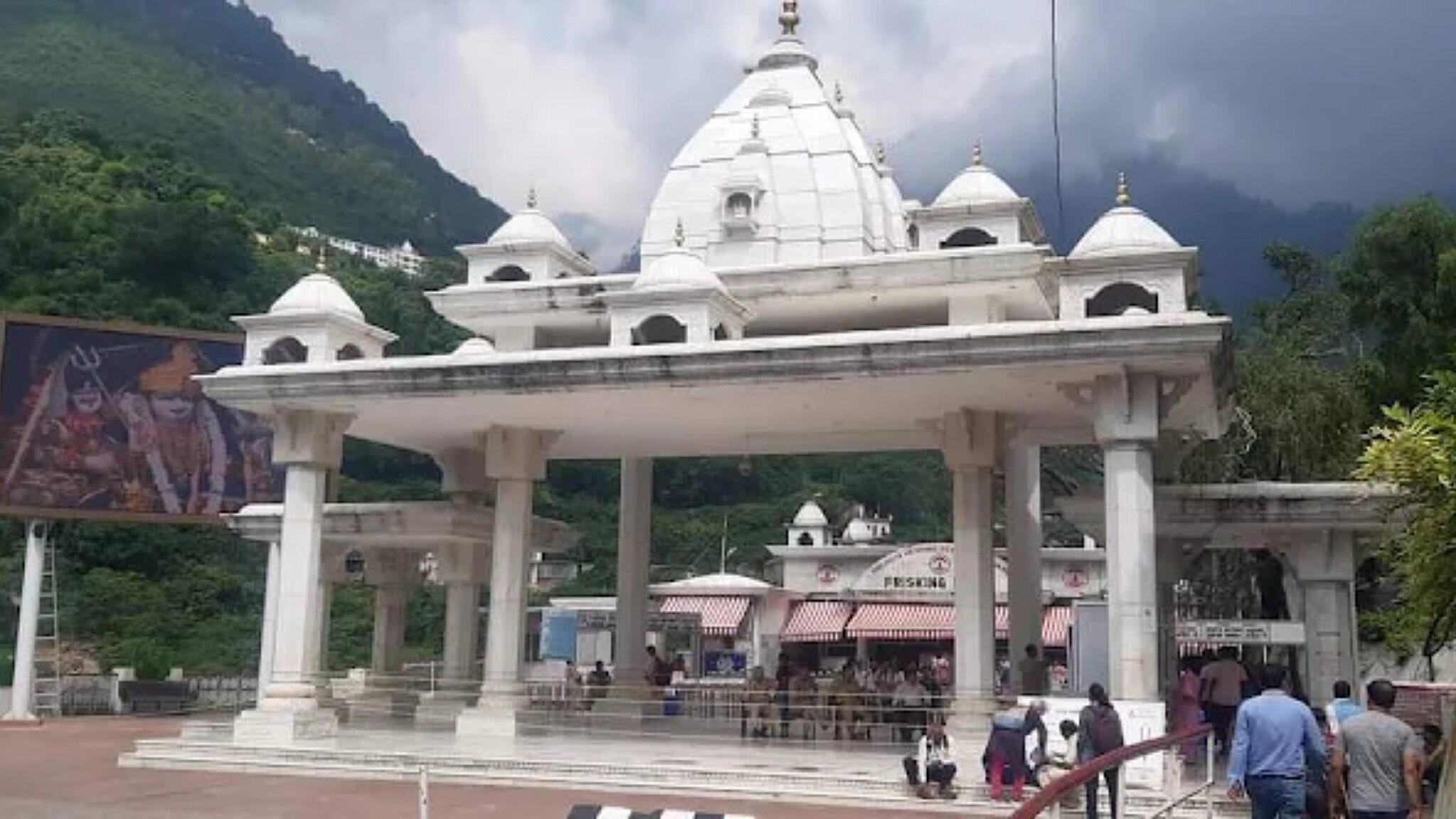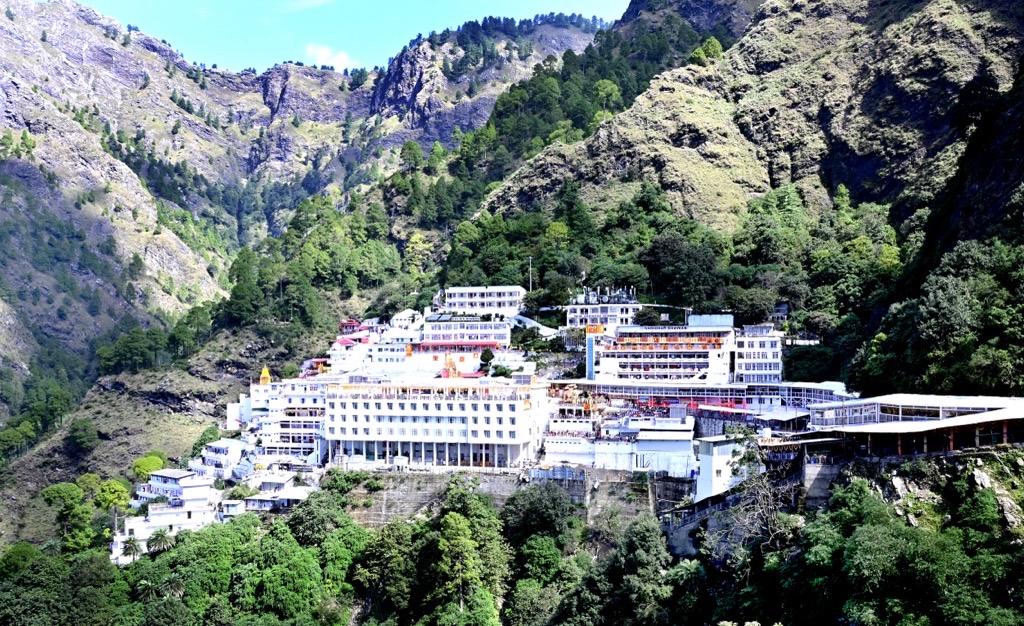Vaishno Devi, located in the picturesque state of Jammu and Kashmir, is one of the most revered pilgrimage sites in India. Every year, millions of devotees from all corners of the country flock to this holy place to seek the blessings of Mata Vaishno Devi. The journey to Vaishno Devi is not just a physical one; it is a spiritual odyssey that takes you closer to the divine.
Vaishno Devi is also known as Mata Rani, Trikuta, Ambe, and Vaishnavi, and is a manifestation of Mother Durga. The manifestation is a combination of goddesses Mahakali, Mahalakshmi, and Mahasaraswati (Kali, Lakshmi, and Saraswati).

The Spiritual History of Vaishno Devi Shrine
There are many different tales as to the creation of the holy site of Vaishno Devi temple.
Vaishnavi and Bhairon Nath
According to one tradition, about 900 years ago, Kali, Lakshmi, and Saraswati once pooled their divine energy to create a girl who would be born on Earth. Her name was Vaishnavi, and her purpose was to uphold righteousness to help fight against evil forces threatening Earth.
She was born into the house of Ratnakar and his wife because they were devout followers of the Devis. With this life, she was to practice righteousness and grow herself spiritually with the promise that when she had evolved enough, she would merge with Vishnu.
Vaishnavi had an insatiable appetite for knowledge. Eventually, she realized that the knowledge she hungered for could only be found within herself, so she began to meditate relentlessly. She even became an ascetic and meditated in the woods, away from material things.
While there, Lord Rama appeared, and Vaishnavi recognized him immediately. She asked to merge with him, but Rama knew it wasn’t the right time because Vaishnavi hadn’t reached the suitable level of spiritual evolution yet, and he was currently serving exile. He told Vaishnavi he would return after his exile, and if she recognized him then, he would merge with her.
Sometime later, after Rama had won his battle and was no longer exiled, he returned to Vaishnai in the disguise of an old man. Unfortunately, Vaishnavi did not recognize him. Rama assured her that it was alright and that it simply wasn’t time yet.
"The Goddess is Maya, embodiment of all delusions. She is Shakti, personification of energy. She is Adi, primal, as ancient and boundless as the soul...The embodiment of Adi- Maya-Shakti – Durga is the invincible one. She is at once bride and warrior. The one establishes home, provides pleasure, produces children and offers food." Devdutt Pattanaik, in Myth = Mithya (2008)
He told her that the time would come in the time of the Kali Yuga when he was in his Kalki incarnation. In the meantime, Rama instructed Vaishnavi to set up an ashram in the base of the Trikuta Hills, so she could meditate and encourage others to do the same, which would help relieve the suffering of the poor and destitute.
She did so, and soon gained popularity. People from far and wide visited her ashram to meditate and receive her blessings. After some time, MahaYogi Guru Goraksh Nath ji had a vision about the interaction of Vaishnavi and Rama, and sent his disciple, Bhairon Nath, to find out more about her.
Bhairon Nath observed Vaishnavi and became enamoured by her, eventually asking her for her hand in marriage. Vaishnavi, completely uninterested in marriage to anyone but Vishnu, tried to avoid him to prevent a confrontation. However, he would not relent, and at a holy feast, he tried to grab her.
Vaishnavi quickly fled to the mountains, stopping at several holy sites along the way, so she may continue meditating in peace. Bhairon Nath followed her anyway, all the way to the cave she was meditating in, known as Bhavan. There, Vaishnavi realized the only way to stop him was to kill him.
With the full power of the Devis who made her, Vaishnavi threw a divine trident at Bhairon Nath and beheaded him. His head was thrown far away before landing on the mountains. In death, he finally realized his mistake of chasing Vaishnavi against her wishes and asked for forgiveness from Vaishnavi as a goddess.
Vaishnavi forgave him due to his apology and prayer and granted him the boon that people will not remember him as a brute, but will instead visit his head after visiting her shrine, or else the pilgrim’s yatra will be incomplete.
At this time, Vaishnavi decided to stop being human altogether and turned into a 5ft tall stone with three heads, or Pindies, representing the three powers inside her.

The Discovery of Vaishno Devi Holy Site
Meanwhile, the Pandit whom Vaishnvi knew in life, who was hosting the holy feast at which Bhairon Nath tried to grab the girl, was devastated at the disappearance of Vaishnavi. This man, Shridhar, prayed for her return, but of course, she did not return.
Instead, she appeared to him in a vision and told him to come find her in her holy cave, Bhavon. She told him the way and he indeed went and found the cave.
Vaishnavi appeared as a goddess in the cave and granted Shridar the right to worship her idol.
Historical Information on Vaishno Devi Shrine
Historical research and documentation show that the cave itself is millions of years old. Of course, the legend is estimated to have happened about 900 years ago. This is supported by historical evidence in the cave that shows that there likely wasn’t much activity in the cave until that time. There may have been some historical worship of the mother goddess Durga there before, but a temple was not built.
It’s estimated that the site was discovered about 700 years ago, but there are no official records.
In 1986, the official Shri Mata Vaishno Devi Shrine Board was formed and the temple as we see it today began to be built.
Like many temples in India, Vaishno Devi Shrine is steeped in much more religious and mythological history than documentable history.

Why is Vaishno Devi Shrine So Famous?
The atmosphere of the trek and the temple itself, combined with the religious significance of the temple all contribute to the popularity of the temple as a pilgrimage and sightseeing destination today.
Uplifting the Spirit
As you make your way to the Vaishno Devi Temple, the aura of divinity envelops you. The temple, perched atop the Trikuta Mountains at a height of approximately 5,200 feet, offers a panoramic view of the surrounding natural beauty. The air is filled with the fragrance of incense and the sound of devotional chants, creating an atmosphere of tranquility and spiritual awakening.
The Vaishno Devi Mandir holds immense significance for devotees. It is believed that a visit to this temple fulfils wishes and brings about spiritual enlightenment. The divine energy that permeates the temple complex is said to cleanse the soul and grant inner peace. Many devotees also believe that Mata Vaishno Devi protects and guides them through life's challenges, making her a source of solace and inspiration.
The trek from Katra to Vaishno Devi Temple is a journey of self-discovery and devotion. The well-worn path, flanked by lush greenery and cascading waterfalls, offers a serene environment for introspection. Along the way, pilgrims encounter several landmarks such as Banganga, Charan Paduka, and Adhkuwari, each holding its own spiritual significance. The climb can be demanding, but the breathtaking views and the sense of accomplishment make it all worthwhile.
Upon reaching the Vaishno Devi Mandir, devotees are greeted by the magnificent structure that houses the holy shrine. The temple, adorned with intricate carvings and vibrant paintings, exudes an aura of grandeur and spirituality. The inner sanctum, where the sacred Pindies of Maha Kali, Maha Lakshmi, and Maha Saraswati reside, is the focal point of devotion. Pilgrims offer prayers and seek blessings from Mata Vaishno Devi, experiencing a deep sense of connection with the divine.

Religious Meaning
Vaishno Devi Shrine is a Shakti Pitha, one of the major temples that celebrate Shakti (remember, Vaishnavi was a form of three goddesses, and so, also Shakti).
Depending on the source, there are either 51, 52, 64, or 108 Shakti Pithas. 18 of them are considered Astadasha Maha (major temples).
It is believed that these sites are places where the body parts of goddess Sati fell, after her death and during Shiva’s mourning.
It’s believed that Sati’s head fell near the site of Vaishno Devi Temple.
Vaishno Devi temple has its own yatra (pilgrimage) called the Vaishno Devi Yatra. The route for this yatra is as follows:
- Katra (home base town)
- Ban Ganga
- Charan Paduka
- Adhkuwari
- Himkoti
- Sanjhichhat
- Mata Ka Bhawan (the Shrine)
- Bhairon Temple
The entire journey is about 13 km round-trip and can be done in one day at a good pace. There is also a new path that circumnavigates Sanjhichaat and Bhairon Temple and is only 7 km long.
Popularity and Festivals
Vaishno Devi temple is visited by millions of pilgrims every year, due to its importance as a holy site. The most prominent festivals are Navratri and Diwali. In 2022, there were 91.25 lakh yatries. The most was in 2012, when there were 104.95 yatries.
Because of all the visitors, the temple also enjoys a healthy supply of donations from devotees, typically about Rs. 167.23 crores per year.
Navratri and Diwali are the two most prominent festivals celebrated in the Vaishno Devi Temple.
Plan Your Trip to Vaishno Devi Shrine
Entry to the Bhawan and the Yatri is free, however, you will need to arrange to have your things stored while you are embarked upon the Yatra, as things like electronics are strictly prohibited from the entire trek. It’s recommended you carry the least amount of things possible on the trek because it can be strenuous. There are many refreshment stops and Bhojanalayas along the path, so you don’t need to bring your own food or water.
The temple itself is open at all times for devotees with Yatri slips.
Darshan is available except during Aatri, which occurs from 6:20 AM to 8:00 AM, and 7:20 PM to 8:30 PM daily.
During peak visiting seasons (May-July, Spring and Autumn festivals, and New Year), you may have to wait 20 hours for Darshan, therefore it’s recommended to visit during the monsoon season if you want a more expedient visit. Winter visits are also possible, but not suitable for people not prepared to trek in the snow (like young children, the elderly, and those with injuries or movement restrictions).
There is no specific dress code for the temple or Yatri. Ensure to dress appropriately for the climate and the trek.
The temple is located in Katra, on the Trikuta Hills within the union territory of Jammu & Kashmir. It is at l elevation of 1,584.96 m (5,200 ft).
To reach the temple, you can travel by road to Katra, and from there walk, take a palanquin, or ride a pony along the Yatra route.
By train, you can arrive at Katra Railway Station, which is well-connected to other major cities and Jammu. Take a taxi to and from the station.
By air, you can fly to Jammu Airport which is 50 km away from Katra. It’s also possible to hire a helicopter to take you to the temple.
The journey to Vaishno Devi is an immersive experience that takes you on a path of self-discovery and devotion. From the legend of Mata Vaishno Devi to the spiritual haven of the Vaishno Devi Mandir, every aspect of this pilgrimage holds profound significance. So, if you're ready to explore the sacred footsteps and embrace the divine, pack your bags and embark on this soul-stirring journey. Mata Vaishno Devi awaits you with open arms.
References
- Shri Mata Vaishno Devi Shrine Board, www.maavaishnodevi.org/. Accessed 27 Nov. 2023.
- Renu. “Jai Maa Vaishno Devi Temple Routes - Delhi to Katra Station Distance.” Religious & Pilgrimage Tour Packages, 10 July 2019, tours.sacredyatra.com/vaishno-devi/trek-routes-of-vaishno-devi/.
- “Shri Mata Vaishno Devi Shrine.” Shri Mata Vaishno Devi Shrine | Reasi, Government of Jammu & Kashmir | India, reasi.nic.in/tourist-place/shri-mata-vaishno-devi-shrine/. Accessed 27 Nov. 2023.















